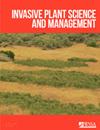模拟高地和湿地生境中芒的生长和控制
IF 1.2
4区 生物学
Q3 PLANT SCIENCES
引用次数: 0
摘要
摘要在全球范围内,巨型芒草(miscanthus×giganteus J.M.Greef&Deuter ex Hodkinson&Renvoize[糖化菌×sinensis])因其能够在多种气候下持续生长而被用作生物燃料作物。然而,很少有研究评估这种植物入侵湿地并在湿地栖息地持续存在的能力。在室外中尺度中,我们研究了M.×giganteus在模拟湿地和高地栖息地的生长能力,并研究了使用水生标记除草剂对这两个栖息地的化学控制策略。在模拟湿地栖息地中,芒草×巨型芒草的生长始终更大,在处理后6周(WAT),湿地植物比高地植物高2.4至3倍,在处理12周时,湿地植物是高地植物高2.8至3.3倍。湿地中的芒×巨型地上生物量在6瓦特时是陆地植物的12.7至17.7倍,在12瓦特时是9.6至12.5倍。湿地地下生物量在6瓦特时是旱地植物的4.5至10.7倍,在12瓦特时是陆地植物的4.0至6.1倍。在这两个栖息地,芒属×巨型芒属地下生物量始终大于地上生物量,分别为6倍(湿地为6.0倍,高地为2.9倍)和12倍(湿地和高地分别为3.8倍和1.3倍)。一般来说,在12WAT下,与未处理的植物相比,所有除草剂处理都降低了M.×giganteus的高度(减少66%至100%)和生物量(减少84%至100%);然而,草甘膦(5716.3 g ai ha–1)和伊玛扎吡(1120.8 g ai ha-1)的表现要好于伊玛扎莫(560.4 g ai ha-1)和哌诺沙仑(98.6 g ai ha-1)。这是第一项提供证据,证明M.×giganteus可以在湿地栖息地进行化学控制。此外,这是第一项表明penoxsulam(一种抑制乙酰乳酸合酶的除草剂)可以减少M.×giganteus在高地或湿地栖息地的生长的工作。本文章由计算机程序翻译,如有差异,请以英文原文为准。
Miscanthus × giganteus growth and control in simulated upland and wetland habitats
Abstract Globally, giant miscanthus (Miscanthus × giganteus J.M. Greef & Deuter ex Hodkinson & Renvoize [sacchariflorus × sinensis]) is used as a biofuel crop due to its ability to persist in a wide range of climates. However, little work has assessed this plant's ability to invade and persist in wetland habitats. In outdoor mesocosms, we examined M. × giganteus's ability to grow in simulated wetland versus upland habitats and examined chemical control strategies for both habitats using aquatic-labeled herbicides. Miscanthus × giganteus growth was consistently greater in simulated wetland habitats, with wetland plants 2.4 to 3 times taller than upland plants at 6 wk after treatment (WAT) and 2.8 to 3.3 times taller than upland plants at 12 WAT. Miscanthus × giganteus aboveground biomass was 12.7 to 17.7 times greater in wetland-versus upland-grown plants at 6 WAT and 9.6 to 12.5 times greater at 12 WAT. Belowground biomass was 4.5 to 10.7 times greater in wetland versus upland grown plants at 6 WAT and 4.0 to 6.1 times greater at 12 WAT. Miscanthus × giganteus belowground biomass was always greater than aboveground in both habitats at 6 (6.0 times greater in wetlands and 2.9 times greater in uplands) and 12 WAT (3.8 times greater in wetlands and 1.3 times greater in uplands). Generally, all herbicide treatments reduced M. × giganteus height (66% to 100% reduction) and biomass (84% to 100%) compared with nontreated plants at 12 WAT; however, glyphosate (5,716.3 g ai ha–1) and imazapyr (1,120.8 g ai ha–1) performed better than imazamox (560.4 g ai ha–1) and penoxsulam (98.6 g ai ha–1). This is the first work to provide evidence that M. × giganteus can be chemically controlled in wetland habitats. Furthermore, this is the first work to show that penoxsulam (an acetolactate synthase–inhibiting herbicide) can reduce M. × giganteus growth in upland or wetland habitats.
求助全文
通过发布文献求助,成功后即可免费获取论文全文。
去求助
来源期刊

Invasive Plant Science and Management
PLANT SCIENCES-
CiteScore
2.20
自引率
9.10%
发文量
24
审稿时长
6-12 weeks
期刊介绍:
Invasive Plant Science and Management (IPSM) is an online peer-reviewed journal focusing on fundamental and applied research on invasive plant biology, ecology, management, and restoration of invaded non-crop areas, and on other aspects relevant to invasive species, including educational activities and policy issues. Topics include the biology and ecology of invasive plants in rangeland, prairie, pasture, wildland, forestry, riparian, wetland, aquatic, recreational, rights-of-ways, and other non-crop (parks, preserves, natural areas) settings; genetics of invasive plants; social, ecological, and economic impacts of invasive plants and their management; design, efficacy, and integration of control tools; land restoration and rehabilitation; effects of management on soil, air, water, and wildlife; education, extension, and outreach methods and resources; technology and product reports; mapping and remote sensing, inventory and monitoring; technology transfer tools; case study reports; and regulatory issues.
 求助内容:
求助内容: 应助结果提醒方式:
应助结果提醒方式:


